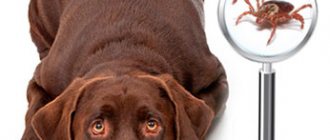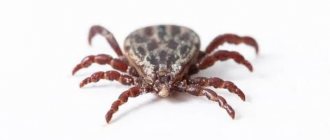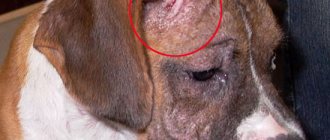Types of ticks and their level of danger
A tick is an arthropod arachnid that leads a parasitic lifestyle. It is often mistakenly classified as an insect. It's quite easy to remember their differences. Arachnids have an additional, fourth pair of limbs.
The arthropod occurs in 4 forms: egg, larva, nymph and adult. Only eggs are not adapted to self-feeding, so all other forms are dangerous for warm-blooded individuals and humans.
All known species are divided into 3 large groups:
- External
. They attach themselves to the outside of the body and are among the most dangerous. This group includes ixodic and encephalitic individuals that carry piroplasmosis, borreliosis and encephalitis.
- Subcutaneous
. They parasitize under the skin, penetrating into it from the external environment. Infection occurs locally or generalized, that is, it covers a certain area or the entire body of the animal.
- Intradermal
. They live inside the body in a dormant form from the moment of birth. They pose a danger when certain factors occur.
Ixodid ticks are held on to the fur by tiny spines covering 4 pairs of limbs. Their oval body is covered with a dark chitinous shell. While feeding, they cut the skin with teeth on their proboscis and inject an anesthetic. The body of the parasite, filled with blood, increases 3 times.
Subcutaneous include the white or yellowish-white sarcoptes scabiei, which causes sarcoptic mange, and the dirty gray notoedres, which causes notoedrosis (scabies). The size of these bloodsuckers does not exceed 0.45 mm.
The smallest representative is the subcutaneous demodex canis, which is light gray in color. The length of its cigar-shaped body is 0.2-0.3 mm. The parasite lives in the sebaceous glands and hair follicles.
How does babesiosis become infected?
Ticks can be called both the main and intermediate hosts of protozoa. They become infected from rats and other small rodents that are not susceptible to Babesia.
In the body of ticks, Babesia reproduce both sexually and asexually. They pass through the stage from larvae to imago, and are transmitted through eggs to the next generation of arthropods. Ticks, to which the infection is inherited, become completely infected. In particular, Babesia enter the salivary glands.
When a tick bites through an animal's skin, the protozoa enter the bloodstream with saliva. They immediately invade red blood cells and begin to multiply, destroying red cells. When red blood cells rupture, new parasites emerge and infect other blood cells. Therefore, ticks are not the only route of infection.
Infection can also occur:
- when receiving blood transfusion from a sick animal;
- from bitch to litter;
- with bites (for example, during a fight).
What diseases do ticks carry?
If a dog is bitten by an uninfected tick, then its health is not in danger. But in cases where the parasite is a carrier of the infection, things become more serious.
A tick can carry not only the well-known borreliosis and encephalitis, but also other, less dangerous, but still unpleasant diseases.
Encephalitis
This is an inflammation of the brain, which often ends in the death of the infected person. The success of treatment depends on the strength of the immune system, as well as on the promptness of taking first measures. Symptoms of encephalitis in dogs include paralysis and convulsions, lethargy, loss of consciousness, and headache.
Borreliosis
The second name is Lyme disease. A dangerous neurological disease can cause complete or partial paralysis, as well as arthritis. The first signs are inflammation of the joints and, consequently, lameness. The dog is in pain, and this manifests itself in lethargy, decreased activity, and sometimes unfriendly behavior or whining.
Piroplasmosis (babesiosis)
Quite often, dogs avoid the first two dangerous diseases when bitten by a tick, but become infected with piroplasmosis. This disease is typical only for quadrupeds.
The first manifestations are lethargy, shortness of breath, fever, vomiting or diarrhea, a little later jaundice is detected, the dog may experience pain in different parts of the body.
Bartonellosis
An extremely unpleasant disease that can be fatal if it is asymptomatic. But most often it manifests itself with the following symptoms:
- apathy, loss of appetite;
- temperature increase;
- inflammation - from external to internal;
- sudden weight loss;
- disruption of the heart;
- capillary hemorrhages;
- in severe cases - pulmonary edema.
With timely treatment, the disease can be completely defeated.
Ehrlichiosis
This is a hematological disease (imbalance of blood cells) that manifests itself in a high fever. It is also accompanied by other severe symptoms depending on the variety: hemorrhages and bleeding, fever, cramps, inflammation, etc.
Hepatozoonosis
The insidiousness of this disease lies in the fact that an animal can become a carrier without manifestations. As soon as his immunity weakens, hepatozoonosis will manifest itself with fever and discharge from the eyes. They may be accompanied by severe pain in muscles and joints.
Why is a tick bite dangerous for a dog?
The main danger that the ixodid tick poses is its ability to carry serious infections, infecting a large number of animals. The consequences of a tick bite for a dog can result in serious damage to internal organs due to piroplasmosis, bartonellosis, ehrlichiosis, and even the death of the animal.
There is no need to panic, because not all ixodid ticks, but only a tenth of the entire population, are carriers of blood-parasitic infections that destroy red blood cells in the body.
In order to prevent infection, it is necessary to promptly treat the dog against ticks, especially during the peak of parasite activity and in those regions where there are more deciduous shrubs and trees. If a tick is discovered by the owner, it must be removed properly.
You cannot pull the parasite out of the skin, since the tick burrows quite deep into the skin. With a sharp detachment, the oral apparatus of the ixodid tick can remain under the skin and cause the development of an inflammatory process.
It is also important to monitor the condition of the animal for the first 3-4 days after the tick is discovered and removed. When affected by blood-parasitic infections, the animal’s condition worsens and intoxication of the body occurs. The dog may develop febrile conditions, lethargy and severe weakness. The pet refuses to eat and may refuse water.
Can a person become infected?
Not only four-legged animals, but also humans can become infected from an arachnid. The list of the most dangerous diseases includes encephalitis and Lyme disease (borreliosis). They cause irreversible neurological changes that can only be treated in the early stages.
“
It should be noted that the diseases mentioned are dangerous for people, but they are not transmitted from dogs to humans. The risk only arises when an infected tick brought by a dog bites a person. Therefore, anti-tick treatment of your pet should be carried out in completely covered clothing.
Rare types of encephalitis can be transmitted through saliva and other secretions of an animal. But usually tick-borne encephalitis is contracted only from a parasite bite. Borreliosis is not transmitted at all from animals to humans.
A less dangerous disease, ehrlichiosis, can also occur in humans and dogs when bitten by a tick, but they cannot become infected from each other.
But the scabies mite easily travels through the air between all mammals. Therefore, it is recommended to isolate a dog infected with a subcutaneous tick from other residents, and treatment measures should be carried out wearing gloves and special clothing.
Diagnostics
The doctor makes a diagnosis based on clinical symptoms, medical history, and laboratory tests of the tick, which the dog’s owner brings to the clinic. The parasite is removed from the pet using a tick remover and placed in a bottle or zip bag.
If laboratory tests do not detect a pathogen, the dog is monitored and chemotherapy is not prescribed because the medications have side effects.
If the owner notices that the pet’s urine has darkened, it is taken for analysis. It is possible to detect the parasite in a blood smear no earlier than 2 weeks after the bite, so this research method is rarely used. If the doctor deems it necessary, the pathogen will be identified using a PCR test.
Symptoms and signs of a bite
Most often, a tick bite in a dog causes burning and itching. More severe symptoms are explained by an infection transmitted through the parasite's saliva or a weak immune system. The resulting reactions are divided into 3 groups:
- Are common
. Problems with coordination arise, bowel movements are disrupted, activity and appetite decrease. The dog is constantly itching.
- Local
. Symptoms of a tick bite in a dog include swelling, redness or purulent inflammation, itching and pain at the site of the insect's attachment, and an increase in local temperature.
- Neurotoxic
. After a tick bite, a dog develops “tick paralysis.” The hind and front legs begin to fail, the swallowing reflex is disrupted, shortness of breath appears, and the volume and audibility of barking decreases. Without timely assistance, the animal dies from suffocation due to spasm of the larynx.
The signs that appear depend on the type of arachnid; you can see them in more detail in the example table.
| View | Symptoms |
| External |
|
| Subcutaneous |
|
| Intradermal |
|
“ The most dangerous signs of a tick bite in a dog are a change in the color of the urine and the appearance of seizures.
The first sign indicates piroplasmosis, and the second sign indicates encephalitis. If an animal becomes infected with one of these diseases, it must receive medical attention within 2-5 days. Otherwise it dies.
Do cats get piroplasmosis?
The causative agent of canine piroplasmosis, Babesia canis, is harmless to cats, but Babesia felis, also carried by ticks, can cause harm.
Despite the fact that piroplasmosis develops very rarely in felines, and many veterinarians generally deny the possibility of infection, owners of domestic cats should not let down their vigilance.
Symptoms such as:
- lack of appetite
- Bad mood
- elevated temperature
- darkening of urine
- pallor or yellowing of mucous membranes
- disorders of the gastrointestinal tract
may be the first signs of the development of piroplasmosis and, in the absence of proper treatment, can quickly kill the animal.
Cats suffer from piroplasmosis
Causes of infection and possible consequences
External and subcutaneous mites are transmitted by contact with an infected mammal or contaminated items. The risk group includes puppies, elderly dogs, animals with chronic diseases and purebred pets with a good pedigree. The consequences of a tick bite in dogs from this group are always more severe.
Intradermal arachnids that cause demodicosis become pathogenic when the immune system is sharply weakened. This occurs when the following factors
:
- pregnancy and childbirth;
- stress and mental disorders;
- estrus;
- docking of ears or tail;
- recent surgeries;
- change of teeth;
- long-term use of antibiotics;
- poor quality nutrition;
- hypothermia or overheating of the body;
- infectious and autoimmune diseases.
Demodex canis is often seen in German Shepherds, Great Danes, Boxers, Afghan Hounds, English Bulldogs, Collies, Doberman Pinschers, Dachshunds, Bobtails, Cocker Spaniels and Chihuahuas. The disease is transmitted from mother to puppies, but is not considered dangerous to other animals or humans.
Demodicosis manifests itself in 2 forms: scaly and pustular. In the first case, redness and cracks appear on the skin, in the second - pustules and ulcers.
Symptoms of the disease are observed only in one place, but if left untreated, they spread to neighboring areas. The resulting wounds attract pathogenic microorganisms. Possible complications include sepsis from a secondary infection, which reduces the chances of recovery by up to 50%.
“ Symptoms of a tick bite in a small breed dog are more pronounced than in larger animals.
The effects of a neurotoxic reaction develop more quickly in small dogs. If an encephalitis tick has bitten a Spitz or Toy Terrier, then immediately seek help from the nearest veterinary clinic.
Other dangerous consequences include the following diseases: ehrlichiosis, hepatozoonosis and bartonellosis. They can be recognized by a delayed reaction, the appearance of purulent discharge from the eyes or bleeding from the nose. All these signs appear in late stages and are difficult to treat.
Symptoms of encephalitis in dogs
Of course, encephalitis is primarily dangerous for humans, but if the immune system is weakened, the dog can also get sick. The bite of an encephalitis tick causes severe symptoms. The incubation period is about 2-3 weeks. Typically, there is an increase in temperature, convulsions, impaired motor functions, and paralysis. A characteristic symptom is hypersensitivity of the head and neck, severe pain. A change in mood may occur - apathy or aggression, and later - paralysis of the facial and eye muscles. There is obvious brain damage, and since there is no specific treatment for encephalitis for dogs, the prognosis is unfavorable: almost one hundred percent death. Symptoms may go away after the first deterioration, but this is not a cure, but a sign of a suppressed immune response. The encephalitis tick has no special signs.
What should the owner do?
A tick bite on a dog is always accompanied by licking of the wounds left by the parasite's proboscis. If you are sure or at least suspect an infection, contact your veterinarian.
Dosages of acaricidal drugs used to combat arachnids are selected individually. Self-treatment is unacceptable. Most animals left without qualified help do not survive.
First aid and diagnostics
Most often, parasites attack weakly protected areas: the hind and front legs, armpits, ears, groin and abdomen. A bloodsucker that has eaten its meal grows to the size of a large bean, so it is easy to notice upon detailed examination.
If you are providing first aid to your dog for a tick bite, wear protective gloves. Do not forget that small arachnids are dangerous not only for your four-legged pet, but also for its owner.
For safe removal, a set of Tick Twister tweezers will be useful. This tool removes the attached parasite with minimal risk. If you don’t have tweezers at hand, you’ll have to do it the old fashioned way. For this you will need:
- Fingers
. Everyone has it, so there shouldn't be any problems. Wrap them in a clean cloth or bandage. Grasp the body of the arthropod in the place where it is attached and twist it in a certain direction. Move clockwise or counterclockwise without changing the original order.
- Tweezers from a manicure set
. Grab the body of the parasite where it enters the skin, placing the tips of the instrument horizontally. Without loosening your grip, begin to twirl the tweezers. Avoid direct upward pulls. After successful extraction, treat the wound with an antiseptic.
If a tick has bitten a dog, then it can only be helped with the tools listed above.
Kerosene, oil or gasoline form an impenetrable film or caustic vapor. The arachnid dies from lack of oxygen or poisoning immediately after transmission of the infection. Thread loops are also prohibited. Due to the tension, the tick often loses its head, so it has to be searched for and removed with a heated needle.
“Within 2 days, the insect can be transferred to the clinic for detailed diagnosis. For this, a tightly closed jar with wet cotton wool inside is useful.
If you do not have the specified time, burn it, scald it with boiling water, or simply crush the insect between several layers of thick paper.
After first aid, rush to the veterinarian for diagnosis. Immediately after a tick bite, your dog should not be given antipruritic medications. They will distort the clinical picture and prevent the correct diagnosis. Relieving itching with the help of drugs is only permissible if the victim cannot be taken to the clinic on the day of infection.
At the veterinary clinic, a visual examination and medical history is taken. After becoming familiar with the individual factors that can influence the development of the disease, the doctor takes a blood and urine test.
Their study determines the presence of toxins released during the life of parasites. Scraping is used to identify their type, and ultrasound and x-rays are used to track internal pathologies.
The duration of treatment depends on the type of disease, degree and duration of infection.
Features of treatment
The recovery period takes from 4 to 8 weeks. Therapy is based on detoxifying the body and eliminating secondary infections. Drug treatment includes taking:
- antihistamines that relieve itching;
- minerals and vitamins that stimulate the immune system;
- acaricidal drugs that act directly on parasites;
- hemostatic agents;
- diuretics that remove accumulated toxins;
- hepatoprotectors that ease the load on the liver.
A tick bite on a dog, accompanied by severe intoxication, requires a mandatory blood transfusion.
When handling a pet infected with notoedrosis or sarcoptic mange, you will need protective gloves. After handling this medication, wash your hands thoroughly. Acaricidal drops are always instilled into both ears, even when only one is affected.
“If affected by demodicosis, the pet is rejected from breeding and sterilized.
Regardless of the form of the disease, the dog is cut and treated with peroxide. After cleansing, wash it with antiseborrheic shampoo. The scheme for subsequent treatment of ulcers and suppurations is agreed with the veterinarian.
This disease is characterized by relapses. Visit the veterinary clinic for preventative purposes at least 2 times a year, even after recovery.
In addition to drug treatment, it is necessary to limit physical activity. Daily walks at a slow pace are welcome, but intense training will have to be abandoned until complete recovery.
“ During treatment, a gentle diet is recommended. Fatty and heavy foods are prohibited. The diet is based on oatmeal, chicken fillet and beef tenderloin. All food should be at room temperature. Avoid reheating. Familiar delicacies are replaced with rosehip decoction.
Of all the diseases considered, only the extreme stage of encephalitis, accompanied by extensive inflammation of brain tissue, cannot be treated. The only humane solution to such an infection is euthanasia.
How is piroplasmosis treated in dogs?
The sooner treatment for piroplasmosis begins, the higher the animal’s chance of survival. Recovery will last 4–5 weeks at best.
For proper treatment, it is important to exclude similar ailments: liver damage, poisoning, leptospirosis, glomerulonephritis, plague.
It is urgent to do blood and urine tests. A blood test will help quickly identify babesiosis by the many destroyed red blood cells and piroplasms in them. Hemoglobin in the urine of a sick dog confirms the diagnosis.
Stage-by-stage treatment:
- Antiparasitic drugs: Veriben, Berenil, Azidine (diminazine) - less toxic. Stronger: Imidocarb, Imizol, Piro-stop.
- Alkalization of urine for normal kidney function. Sodium bicarbonate is injected intravenously to prevent blockage of the renal tubules by hemoglobin crystals. The animal is also given a solution - 2 g of soda per 10 kg of body weight until the hemoglobin is completely removed from the urine. Instead of soda, you can give the drug blemaren - 1 tablet per 10 kg of weight per day.
- Vitamins, diuretics, glucose, tonic, hemostatic.
- Purification of blood by transfusion or filtering.
- A recovered dog should be limited in movement for 10-15 days. Special care and diet will be required.
After the disease, unstable immunity lasts 4-6 months. Afterwards, there is a risk of becoming infected with piroplasmosis again.
Prevention recommendations
Infection cannot be ruled out, but the risk can always be reduced. Important for your pet's health
:
- Don't neglect vaccination. Passive immunity lasts for six months. Even if infected, a vaccinated individual will tolerate the disease more easily.
- Limit communication with unfamiliar four-legged animals. Most often, stray dogs and wild animals become carriers. And playing with a fluffy squirrel is fraught not only with invasion, but also with rabies.
- Carefully inspect hard-to-reach places on your body after each walk. The speed at which the first symptoms appear varies from person to person. If no signs are found, then repeat the skin examination after a couple of hours.
- Control your diet. A proper and balanced diet is the key to a strong immune system.
- Contact a veterinary clinic for help with any questions or suspicions. It is better to make mistakes several times than to lose your beloved dog due to carelessness.
- Use anti-tick agents during periods of increased parasite activity: from April to October. If the dog has long hair or profuse sweating, which requires frequent washing, increase the recommended dosage of medications.
- Avoid mating if infestations are detected. Feel free to ask for information from the second owner.
- Sterilize after infection with subcutaneous parasites. Not only future offspring can suffer, but also the bitch herself. Relapse of the disease occurs against the background of any hormonal changes.
Antiparasitic agents include vaccines, collars, sprays and drops. Each of them has its own advantages and disadvantages.
Vaccine
Giving your pet a vaccine will reduce the likelihood of infection. The most popular include “Nobivak Pro” and “Pirodog”. These vaccines protect against piroplasmosis. Only healthy animals are allowed to be vaccinated. Vaccination after infection is pointless.
To consolidate the result, a second vaccination is given 1 month after the first vaccination. All subsequent ones are done once every six months independently or in a veterinary clinic.
Collars
Collars last for more than six months, but often cause local allergic reactions. If your pet's hair falls out, you will have to abandon the collar in favor of drops or sprays.
“ Due to the ingredients included, the collars are not suitable for nursing or pregnant women, puppies under 2 months of age, or animals with chronic illnesses.
The smell emitted by the product repels insects and remains on the body for some time even after removal. According to the method of exposure, they are chemical, biological and ultrasonic. The first two are repelled by the smell of chemicals or essential oils, and the last one is repelled by ultrasound, which is detected only by arachnids. An ultrasonic collar is more expensive than its analogues, but is considered safer.
What to feed your pet with piroplasmosis
If your pet doesn't want to eat, don't force food in. To maintain strength, give your pet food often - take liquid (you can use lean broth) into a large syringe without a needle and squeeze it into the mouth. Don't give me milk!
The diet should be aimed at increasing hemoglobin, immunity, and vitality. If you still have an appetite, give pureed lean meat (turkey, beef, lamb), add a little vegetable oil. Check with your veterinarian whether you can give porridge (rice, buckwheat, wheat) with meat. If yes, cook the cereal and make a puree. If the dog refuses porridge, do not give it.
As an option, you can buy ready-made dietary food intended for animals with diseased kidneys and liver. The dry must be soaked until it becomes a paste, the canned food must be mixed with warm water. The food should not be cold.
Rating of the best tick repellents
The range of drugs is very wide. Veterinary pharmacies offer all kinds of collars, sprays, drops, shampoos, and special dry formulations. The rating of the best anti-tick medications for a puppy will be based on statistics - the most effective products are usually in demand. Some manufacturers have managed to establish themselves well and have firmly established themselves in the market. The following brands can be distinguished:
- Bayer. The company produces Advantix drops, Kiltix and Foresto collars, and Bolfo spray.
- "Merial". FrontLine Combo solution, Frontline spray, FrontLine NexgarD tablets.
In addition, the company produces anti-tick products for dogs of different age categories or breeds:
- "Leopard";
- "Biphar";
- "Hertz";
- "Rolfclub";
- "Stronghold."
The domestic drug, which is in no way inferior to foreign ones, is popular in Russia. It can be found on the shelves of any veterinary pharmacy.
Drugs
Despite the rich assortment, you should not buy the first puppy products you come across. Each release form is toxic and has pros and cons . The most commonly used active ingredients are:
- permethrin;
- diazinon;
- cypermethrin;
- deltamethrin;
- cyfluthrin;
- flumethrin;
- etrachlorvinphos;
- amitraz;
- afoxolaner;
- fluralaner.
Active components are distinguished by degree of toxicity and cost. Please note: Some of these drugs will be effective in treatment, while others will be effective in prevention. If we are talking about therapy, it is also advisable to undergo a series of tests to accurately determine the pathogen. Before choosing how to treat your pet, consult a veterinarian.
What to do if your puppy is bitten by a tick?
If a tick is found, it should be removed immediately. Here, not only the fact of the bite plays a role, but also the duration - all this time piroplasms are released into the animal’s blood. If you are able to take your puppy to a veterinarian, you should do so as quickly as possible. When this is not possible, or a lot of time has already passed, you should remove the tick yourself.
It is more convenient to remove using tweezers:
- The tick is grabbed at the very base, where the proboscis comes into contact with the skin of the animal:
- the tweezers begin to turn in any direction, making “pulling” movements;
- disinfect the affected area.
Thus, the tick should be removed without damage. If tweezers are not available, use a napkin. They wrap it around the tick, and then perform the same actions.
If your dog or puppy is bitten by a tick, but by the time you notice it has already disappeared under the skin, it should also be removed. It is advisable to carry out the manipulation in a veterinary clinic, but some cases require emergency intervention. A parasite that has managed to get under the skin looks like a small swollen ball. Follow the following algorithm:
- Wear medical gloves before removing.
- If necessary, the skin can be carefully opened with a sterile needle.
- Apply vegetable oil, manicure polish, or cologne to the tubercle - this will force the parasite to pull out the head a little. Repeat application of the selected substance for several minutes.
- Then wrap a loop of thread or thin rope around the parasite closer to the proboscis.
- Make rotational movements in one direction.
Usually a couple of turns are enough to remove the arthropod. If the parasite is not detected, but there are signs of a bite, immediately take the dog to the veterinarian for an examination.











